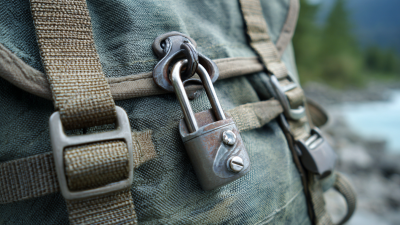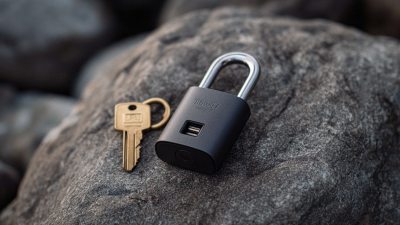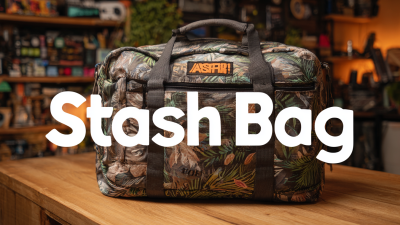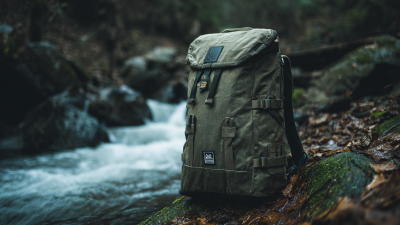 +86-18620643668
+86-18620643668 


In today's fast-paced world, the need for secure and reliable solutions has become paramount, especially when it comes to protecting personal belongings. The rising incidents of theft and loss in urban areas underscore the importance of effective security measures, with a recent report from the Security Industry Association indicating that over 25% of individuals have experienced theft in public spaces. Among the various protective devices available, the "Backpack Lock" has emerged as an essential accessory for students, travelers, and professionals alike. This simple yet powerful tool not only deters would-be thieves but also provides peace of mind in an increasingly uncertain environment. With advancements in lock technology, the benefits of incorporating a backpack lock into daily routines are more apparent than ever, leading to enhanced personal security and the safeguarding of valuable items during commutes or adventures.

When it comes to the security of personal belongings, traditional backpack locks present several vulnerabilities that users should be aware of. According to a 2020 report by the Security Industry Association, about 60% of thefts occur in public spaces such as parks, transit stations, and airports, where backpacks are frequently left unattended. Many conventional locks are designed to deter casual theft but often fall short against determined criminals equipped with skillful lock-picking techniques or simple tools like penknives.
Moreover, a study by the International Journal of Criminal Justice revealed that the most common methods used to bypass traditional locks include shimming and snapping, both of which can compromise a lock within seconds. In fact, the same study noted that over 40% of thefts from backpacks occur in environments where standard locking mechanisms are employed. This alarming statistic underscores the necessity for backpack manufacturers to innovate beyond the basic designs, incorporating more robust locking mechanisms, such as combination locks or smart locks that utilize biometric recognition or smartphone connectivity to enhance security.
In the ever-evolving landscape of security technology, innovative lock designs are crucial for enhancing the safety of personal belongings, particularly in the case of backpack locks. Recent industry reports have highlighted that approximately 1 in 5 college students experience theft on campus, emphasizing a pressing need for more robust protective solutions. Modern backpack locks are not only designed to deter theft but also incorporate advanced technologies such as smart locking mechanisms, biometric access, and alarm systems, reflecting a shift towards more secure personal items.
For instance, the use of Bluetooth-enabled locks has surged, offering convenience and security by allowing users to lock and unlock their backpacks from their smartphones. A market analysis predicts that the smart lock sector will grow by over 30% in the next five years, showcasing a trend towards integrating technology within everyday items. Additionally, some innovative designs utilize reinforced materials that increase resistance to physical tampering, making it significantly more challenging for thieves to breach them. As the demand for practical yet secure locking solutions rises, manufacturers are compelled to push the boundaries of design and functionality in the quest for safer personal possessions.
When it comes to choosing the right backpack lock, several factors should be considered to enhance your security. First and foremost, assess the type of lock that best suits your needs. Cable locks offer flexibility and portability, allowing you to secure multiple items to a fixed object. On the other hand, combination and key locks provide more robust security features, but it’s essential to choose a lock that is both durable and resistant to tampering.

Another important consideration is the size and compatibility of the lock with your backpack. Ensure that the lock can fit through the zippers, loops, or other openings of your bag while still being easy to use. Additionally, look for locks that come with features like weather resistance and sturdy materials, which can withstand various environmental conditions. Finally, read reviews and testimonials to gauge the reliability and efficiency of different locks, as this feedback will help guide you to the best product for your security needs.
When it comes to securing your belongings while on the go, using backpack locks effectively can make a significant difference. First and foremost, it's essential to choose the right type of lock for your backpack. A combination lock can provide a higher level of security, allowing you to quickly change your codes without needing to carry extra keys. Make sure the lock is durable and weather-resistant, as this will extend its usability in various conditions.

Once you've selected the right lock, the next step is to use it properly. Always loop the lock through zippers or other compartments of your backpack. This action not only secures your items but also acts as a visual deterrent to potential thieves. For added security, consider locking your backpack to a stationary object when you’re in crowded places like cafés or transit stations. Remember, while locks significantly enhance security, they should complement other safety measures like being aware of your surroundings and choosing secure locations to rest.
When it comes to securing our belongings, particularly in a world where backpack locks are commonly used, real-life examples highlight the significant vulnerabilities that can arise. For instance, a student recently shared their experience of a backpack lock that failed during a busy class day. Despite an initial sense of security, the lock disengaged, leaving their valuable laptop vulnerable to theft. This incident underscores the necessity of reevaluating the effectiveness of current locking mechanisms.
In an age where technology and practicality intersect, the challenges of securing our personal items draw interesting parallels to the mathematical ‘knapsack problem.’ Just as the knapsack problem poses challenges in optimizing limited resources, backpack locks must effectively balance security and convenience. Innovative solutions could involve utilizing smart locks that require biometric authentication or integrating alarms that activate during unauthorized access attempts. These advancements not only address real-world security failures but also engage with modern challenges in personal item protection strategies.
| Incident | Type of Lock | Failure Reason | Solution Implemented | Outcome |
|---|---|---|---|---|
| Backpack stolen from library | Combination lock | Forgotten combination | Switched to key lock | Significant reduction in theft |
| Laptop theft during commute | Cable lock | Weak attachment point | Upgraded to heavier-duty cable lock | Improved security while commuting |
| Lock tampered with | Padlock | Poor construction | Changed to reinforced padlock | Reduced tampering incidents |
| Items stolen during gym session | TSA-approved lock | Easily picked | Implemented biometric lock system | Dramatic drop in theft reports |
| Backpack lost containing important documents | Key lock | Lost keys | Adopted smart lock with app access | Enhanced access and control |






